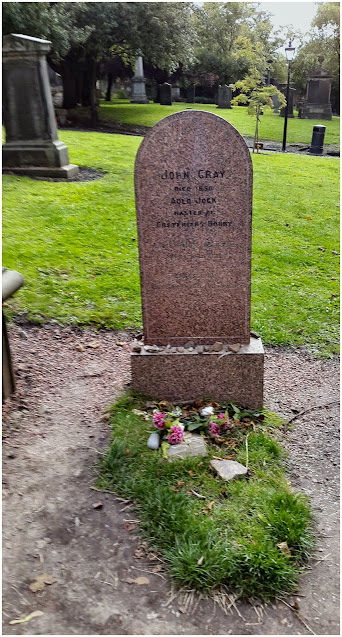 |
| John Gray Grave - Master of 'Greyfriars Bobby' |
His little dog remained faithful to his old master, sleeping on his grave ..... according to legend he supposedly spent the next 14 years guarding the grave of his master until he died himself on 14 January 1872. Also according to the legend, when the faithful hound died the good burghers of Edinburgh put up a statue of 'Bobby' on a drinking fountain outside the church graveyard, and that its there to this day even now.
 |
| Tourists Are Still Attracted To Bobby's Statue |
In the Disney version of the tale, a lot of school children stopped the caretaker from having Bobby evicted from the graveyard .... all together now ahh ... well maybe not. Disney followed this up with a two part TV special about the legend of Bobby. There has since been a remake of the movie in 2005, with its own version of the tale.
 |
| Greyfriars Bobby's Grave (Presumably Bobby mark II) |
Of course the legend has been challenged as just another shaggy dog tale. One historian suggested that in fact, Bobby would go out hunting rats in the church yard and was also kept well fed by the locals. He even suggested that there were in fact two dogs involved, with those before 1867, differing in contemporary drawings and paintings and being a rather ugly dog, with those depicted in later paintings, who looked just like the statue on the drinking fountain. His claims are backed up by examination of the minutes of meetings at Edinburgh City Council for that time, which suggest that the truth about there being a Bobby mark I and Bobby mark II, was well known at the time.
Seemingly, there never was a crofter or shepherd. The original Bobby was a local stray mongrel which had originally hung around the grounds of the George Heriot's Hospital, but was considered a nuisance there, so the hospital gardener dumped him in the grounds of the local Greyfriars Kirk, where he was 'adopted' by James Brown, curator of the graveyard. Mr Brown started spinning the tale of the shepherd and his faithful dog to visitors of the church, apparently to generate some monetary tips .... So when the first 'Bobby' died, he simply bought another 'Bobby' (without making any effort to match the dogs looks), to carry on earning the gratuities.
However even by then, the legend was attracting so many tourists to the Scottish capital, that councillors chose to ignore what was effectively a confidence scam. The graves in the photographs accompanying this post can still be seen in the Kirk graveyard, the entrance to which is a but a few yards from the famous statue and tourist site.
Nothing much changes the Sun, and 150 years later I can't help noting that all the 'William Wallace' tat that the Edinburgh tourist shops sell, is basically Mel Gibson, which is another sort of scam when you think about it.
 |
| William Wallace As Mel Gibson |









As we were saying not so long ago, it's amazing what people will believe, and continue to believe against all the evidence. Not so amazing is how others will take advantage of this phenomenon.
ReplyDeleteThere has been someone selling the Coliseum to a rube since the day Emperor Titus opened it.
DeleteIn 1883 George C Parker (an American) managed to 'sell' the newly completed Booklyn Bridge many times with prices ranging from as little as $50.00 to a whopping $50,000. He also sold other landmarks including Madison Square Garden, Grant’s Tomb, Metropolitan Museum of Art and even the Statue of Liberty. In 1928 he was finally arrested on charges of swindling and received a life sentence in 'Sing Sing' prison, where he later died in 1937.
ReplyDeleteArthur Ferguson, a Scottish actor started conning American tourists in the 1920's by 'selling' them Big Ben and other icons for between $5,000 to $30,000. Of course the UK government sold London Bridge for real to an American Robert P McCulloch for a cool $2,460,000 in 1968.
Still these conmens crime careers prove that there truly is "one born every minute".
Thanks for the comment ... really interesting content.
Delete